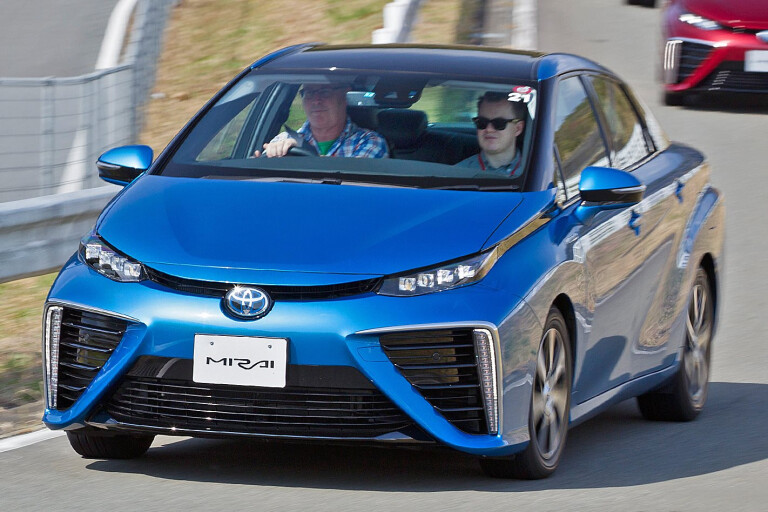
Toyota has developed Mirai as the world’s first full-production fuel cell vehicle. However, even though it has been developed for right-hand-drive markets, it will only be sold where refuelling stations are available. That rubs Australia out of the game.
WHAT IS IT?
The futuristic Toyota Mirai sedan uses high school cookbook chemistry; combine hydrogen with oxygen from the air, and you make water and electricity. The water trickles out into the environment and the electricity powers the sedan’s front wheels.
WHY WE'RE TESTING IT
Toyota Australia says it isn’t in the business of making and selling hydrogen fuel, so it wants someone else to step in and start doing it. In a way, it’s pinning hopes on Aussie journalists driving and liking the Mirai to add weight to the business case to bring it here.
MAIN RIVALS
There are none yet with full-blown production ambitions. Hyundai, which is very bullish on hydrogen in Australia, is believed to be working on a fuel cell version of its Tucson SUV. Honda, meanwhile, has recently updated its Honda FCX Clarity fuel cell vehicle but is stalling on plans to roll it out worldwide.
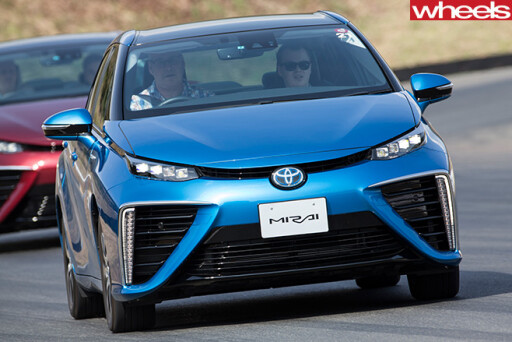 THE WHEELS VERDICT
THE WHEELS VERDICT
The Toyota Mirai is very much an experiment in styling and alternative fuel acceptance. We Aussies like our cutting-edge tech, though – we’re one of the Apple iPhone 6’s strongest markets globally – so it could work here.
PLUS: Good step-off acceleration; dynamics appear to be very well sorted for a Toyota, apart from the tyres; quiet cabin; brakes better than traditional Toyota hybrids
MINUS: Likely to be hideously expensive; science-fiction styling; dash falls short on ergonomics; no plug-in option; wees like an excited dog every time you stop
THE WHEELS REVIEW
LET’S play a bit of word association. What’s the first thing that comes into your head when you hear the word “hybrid”? Toyota Prius? Now let’s do the same thing with the words “fuel cell”. No, no, take your time…
Hydrogen is touted as the fuel of the future. Unlike hybrid, it’s not a fossil fuel extender, but a genuine fossil fuel substitute. And because it sloshes around in a tank, it’s also something familiar and tangible, unlike electricity.
 Toyota appears to want the Mirai to mean the same thing to hydrogen as the Prius did for whacking a great, heavy, expensive battery and an electric motor in the car and calling it the future. It’s the world’s first mass-production hydrogen car, and available in right-hand drive, but only in those markets where some entrepreneurial types take all the risk of spending many hundreds of thousands of dollars to build and operate hydrogen generation and refuelling stations.
Toyota appears to want the Mirai to mean the same thing to hydrogen as the Prius did for whacking a great, heavy, expensive battery and an electric motor in the car and calling it the future. It’s the world’s first mass-production hydrogen car, and available in right-hand drive, but only in those markets where some entrepreneurial types take all the risk of spending many hundreds of thousands of dollars to build and operate hydrogen generation and refuelling stations.
Mirai is a transitional vehicle. Nothing else out on the world’s roads looks like it, with awkward, jagged lines and confused design. Funny thing, but reverse a new fourth-generation Prius up next to the Mirai and you’re hard pressed to tell them apart from opposing ends.
The Mirai’s motive process is simple enough. Mix hydrogen gas and air in a reactive fuel cell stack and the atmospheric oxygen combines with hydrogen to create about 60cc of water for every kilometre travelled, and electricity. The electricity passes to an electric motor borrowed from the development program for the hybrid Lexus RX SUV via an old-school nickel metal hydride battery system that smooths everything out.
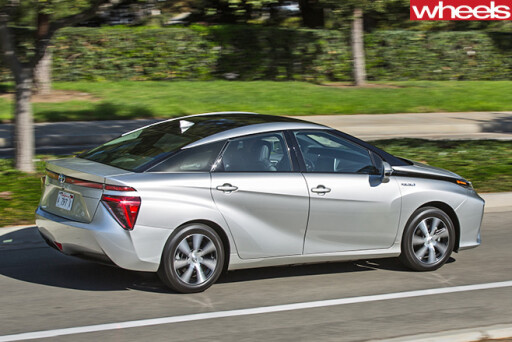 Stitching it all together is a traditional monocoque chassis with special modifications to swallow the two bulky hydrogen storage tanks (one under the rear seat, the other under the boot’s floor) and the fuel cell stack in what would normally serve as the transmission tunnel.
Stitching it all together is a traditional monocoque chassis with special modifications to swallow the two bulky hydrogen storage tanks (one under the rear seat, the other under the boot’s floor) and the fuel cell stack in what would normally serve as the transmission tunnel.
The battery and electric motor fill the under-bonnet space in between the MacPherson struts; a multi-link suspension sits under the boot.
Inside, Mirai is all I, Robot-inspired clean, white, wrap-around lines broken by a digital dash that sits off to one side of the driver, and a high centre console topped with a large touchscreen. Without a head-up display, the speedo’s readout is way out of the driver’s eyeline.
We’re given two controlled laps in the Mirai of the Lexus-owned test track based at Fuji Speedway, about four kilometres in total, so there’s not a whole lot we can learn.
The first thing to note, though, is that, similar to other pure electric cars with a bloated kerb weight, the Mirai’s step-off acceleration is still quite strong, and enough to win the odd traffic light grand prix. It’s even more impressive as rolling acceleration, pulling quickly and keenly.
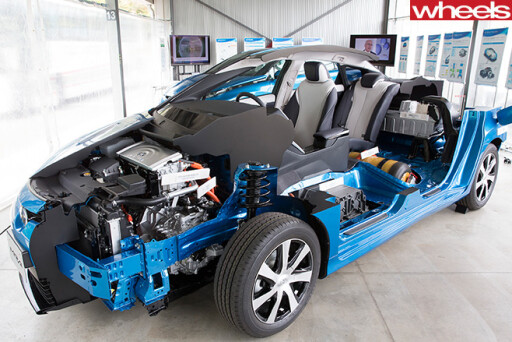 However, when you mash the pedal, the Mirai sounds like no other car. The fuel cell, which Toyota claims produces equivalent power to a conventional 3.0-litre V6 engine, needs a constant flow of air and hydrogen to meet the electrical load on the motor, so a pair of pumps somewhere behind the two rear seats work hard to feed the demand. It sounds something like a service station’s air compressor firing up to top up the tank pressure as you inflate a flat tyre.
However, when you mash the pedal, the Mirai sounds like no other car. The fuel cell, which Toyota claims produces equivalent power to a conventional 3.0-litre V6 engine, needs a constant flow of air and hydrogen to meet the electrical load on the motor, so a pair of pumps somewhere behind the two rear seats work hard to feed the demand. It sounds something like a service station’s air compressor firing up to top up the tank pressure as you inflate a flat tyre.
The reason you notice the pump noise is because everything else in the Mirai is so quiet. The front windows are double-glazed, and the sound isolation from the drivetrain and 17-inch Bridgestone Ecopia low rolling-resistance rubber makes it very hushed.
Toyota’s engineers set up a couple of bump strips for us to try out the suspension at low speeds. It’s difficult to divine much other than the Mirai feels like a heavy car, with the firmish ride recovering quite well from those small hits.
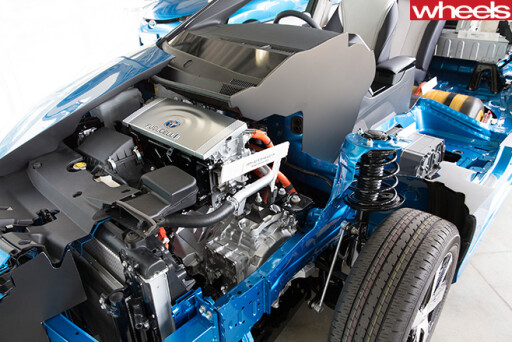 Happily, the regenerative brakes shake the traditional Toyota hybrid legacy of dead pedal travel followed by a wooden feel and a lurch as the electric motor kicks in to scavenge all the energy it can from the car’s momentum. Instead, they’re conventionally smooth and progressive.
Happily, the regenerative brakes shake the traditional Toyota hybrid legacy of dead pedal travel followed by a wooden feel and a lurch as the electric motor kicks in to scavenge all the energy it can from the car’s momentum. Instead, they’re conventionally smooth and progressive.
More telling is a short slalom with a speed cap of, ahem, 30km/h. The Mirai’s taut suspension, quickish steering and low centre of gravity – all the heavy bits are mounted low on the chassis – make it a bit of fun to chuck around with an almost unnoticeable weight transfer.
The limitation, though, are the tyres, which all squeal at once like a pack of teenagers at the sound check for a rock concert, at even moderate speeds.
 The Mirai collects the water it makes and part of the fun is an ‘H2O’ button mounted to one side of the steering wheel that allows you to dump it any time you like. It’s been engineered in so that owners don’t have the embarrassment of the car peeing like an excited dog every time they get out of it in their driveway. The novelty of this meant the Fuji pit lane was covered in damp patches left by water that one Toyota engineer admitted he did drink once, just to see what it was like. “Not good,” was the assessment.
The Mirai collects the water it makes and part of the fun is an ‘H2O’ button mounted to one side of the steering wheel that allows you to dump it any time you like. It’s been engineered in so that owners don’t have the embarrassment of the car peeing like an excited dog every time they get out of it in their driveway. The novelty of this meant the Fuji pit lane was covered in damp patches left by water that one Toyota engineer admitted he did drink once, just to see what it was like. “Not good,” was the assessment.
The Mirai is Toyota’s hedge against rising fuel prices and ever-tightening emissions laws, and the third generation of technology that dates back 23 years. Best of all, though, the experience is almost seamlessly familiar from behind the wheel, and simple enough that anyone could just jump behind the wheel and drive it.
Unfortunately, until we get the refuelling issue sorted, the future of Mirai in Australia appears to be in line with how its emissions taste.
SPECS
Model: Toyota Mirai
Engine: 114kW fuel cell stack and 125kW electric motor
Max power: 113kW
Max torque: 334Nm @ 0-10,000rpm
Transmission: Single-speed reduction gear
Weight: 1850kg
0-100km/h: 10.0sec (claimed)
Fuel economy: the equivalent of 4.2L/100km (estimated)
Price: $80,000 (estimated)
On sale: When the fuel becomes available

COMMENTS